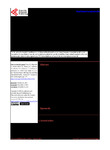Case Study of a Cyber-Physical Attack Affecting Port and Ship Operational Safety
| dc.contributor.author | Tam, K | |
| dc.contributor.author | Hopcraft, Rory | |
| dc.contributor.author | Moara-Nkwe, K | |
| dc.contributor.author | Misas, JP | |
| dc.contributor.author | Andrews, W | |
| dc.contributor.author | Harish, AV | |
| dc.contributor.author | Giménez, P | |
| dc.contributor.author | Crichton, T | |
| dc.contributor.author | Jones, Kevin | |
| dc.date.accessioned | 2022-01-17T13:55:48Z | |
| dc.date.available | 2022-01-17T13:55:48Z | |
| dc.date.issued | 2021-12-06 | |
| dc.identifier.issn | 2160-0473 | |
| dc.identifier.issn | 2160-0481 | |
| dc.identifier.uri | http://hdl.handle.net/10026.1/18567 | |
| dc.description.abstract |
As the maritime sector embraces more technology to increase efficiency, lower carbon emissions, and adapt to meet modern challenges, cyber and cyberphysical safety become a more significant issue. However, unfortunately, much of past research view cyber-security issues in transportation as primarily information technology problems. This paper designs and uses a case study to illustrate how cyber-security and physical safety should be viewed together, cyber and physical (i.e. cyber-physical), when considering ship-to-ship and ship-to-shore interactions. While there is some scenario designing, this case study is built with real port data and ship systems to demonstrate a real-world cyber-attack on a ship. It shows plausible physical effects that affect the safety of those involved. This case study is also made realistic with a novel hybrid cyber range and hardware testbed environment, designed to examine the different effects a ship-based cyber-attack could potentially have on a port. This informs several solutions, technical and social, that could enhance cyberphysical safety in marine transportation. | |
| dc.format.extent | 1-27 | |
| dc.language.iso | en | |
| dc.publisher | Scientific Research Publishing | |
| dc.subject | 7 Affordable and Clean Energy | |
| dc.title | Case Study of a Cyber-Physical Attack Affecting Port and Ship Operational Safety | |
| dc.type | journal-article | |
| plymouth.issue | 01 | |
| plymouth.volume | 12 | |
| plymouth.publication-status | Published | |
| plymouth.journal | Journal of Transportation Technologies | |
| dc.identifier.doi | 10.4236/jtts.2022.121001 | |
| plymouth.organisational-group | /Plymouth | |
| plymouth.organisational-group | /Plymouth/Faculty of Science and Engineering | |
| plymouth.organisational-group | /Plymouth/Faculty of Science and Engineering/School of Engineering, Computing and Mathematics | |
| plymouth.organisational-group | /Plymouth/REF 2021 Researchers by UoA | |
| plymouth.organisational-group | /Plymouth/REF 2021 Researchers by UoA/UoA11 Computer Science and Informatics | |
| plymouth.organisational-group | /Plymouth/Users by role | |
| plymouth.organisational-group | /Plymouth/Users by role/Academics | |
| dcterms.dateAccepted | 2021-12-03 | |
| dc.rights.embargodate | 2022-1-18 | |
| dc.identifier.eissn | 2160-0481 | |
| dc.rights.embargoperiod | Not known | |
| rioxxterms.versionofrecord | 10.4236/jtts.2022.121001 | |
| rioxxterms.licenseref.uri | http://www.rioxx.net/licenses/all-rights-reserved | |
| rioxxterms.licenseref.startdate | 2021-12-06 | |
| rioxxterms.type | Journal Article/Review |


